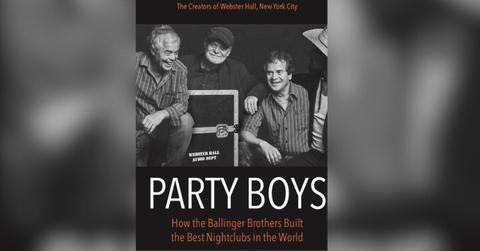
Lon Lon Ballinger's 'Party Boys' book tells some wild stories about New York City nightlife.
From Farm to Fame: Lon Ballinger's 'Party Boys' Book Tells the Wild Story Behind NYC's Nightlife Legends
For fans of New York City nightlife, Webster Hall and its fellow clubs are more than venues — they’re icons of an era, testaments to a time when the city came alive with unrestrained energy and wild revelry. Now, Lon Ballinger, the impresario behind some of NYC's most legendary clubs, is sharing his behind-the-scenes stories in his new book, Party Boys: How the Ballinger Brothers Built the Best Nightclubs in the World. Chronicling the Ballinger Brothers’ journey from their humble beginnings in a small Canadian farm town to creating a nightlife empire, the book offers a captivating look at the grit, glamour and pure audacity that fueled three decades of party history.
Ballinger and his brothers were visionaries, bringing the ethos of big, bold entertainment to New York. They were the masterminds behind legendary clubs like Webster Hall, Big Bop, RockIt, American Beauty, and the Boom Boom Room, venues that collectively attracted over 40 million people to dance, celebrate, and become part of nightlife history. Party Boys doesn’t just catalog the club scene; it draws readers into the heart of New York nightlife, where boundaries blurred, creativity thrived, and anything seemed possible.
One of the book’s standout stories recounts the night Webster Hall hosted former President Bill Clinton’s second inauguration celebration in 1997. Ballinger paints a scene as dazzling as it was surreal: the Secret Service stationed on the roof, 10,000 balloons falling from the ceiling, and go-go dancers in patriotic bikinis bringing the festive spirit alive. The night epitomized the club’s eclectic energy, one that could welcome a presidential party one night and an underground rave the next.

Perhaps one of the most unforgettable nights in Webster Hall’s history was when Prince took over the venue after a dispute with his record label. Known as "the artist formerly known as Prince" at the time, he brought in strict rules: no smoking, no drinking and no meat allowed. But, as Ballinger describes, the fans who packed Webster Hall that night didn’t mind one bit, transfixed by the icon as he played alongside a 35-piece orchestra, proving his magnetic presence and unparalleled talent.
Ballinger even delves into a piece of pop culture mythology involving Madonna, who performed at Webster Hall in 1995 with her then-dancer Carlos Leon. The chemistry between Madonna and Leon was palpable, and as Ballinger reveals, some speculate that their daughter Lourdes may have been conceived that very night. For Ballinger, stories like these illustrate the magical, unexpected encounters that could only happen in the charged, unforgettable atmosphere of a place like Webster Hall.
Party Boys is as much a tribute to Ballinger’s brothers and business partners as it is a memoir. With honesty and humor, he recounts the thrill of building clubs that became destinations in themselves, places where people could escape the ordinary and embrace the extraordinary. From the painstaking attention to detail that went into each club’s design to the endless parade of celebrities, musicians and partygoers who crossed the doors, the Ballinger brothers crafted more than venues — they created experiences.
For those who frequented these clubs or anyone curious about New York City’s nightlife legacy, Party Boys offers an inside look at the life of a man who was as much a part of the scene as the revelers on the dance floor. Ballinger’s story is a testament to an era, a city, and the timeless allure of a good party. Whether you're reminiscing or discovering it for the first time, Party Boys promises to transport readers to the heart of New York’s most thrilling nightlife era.
